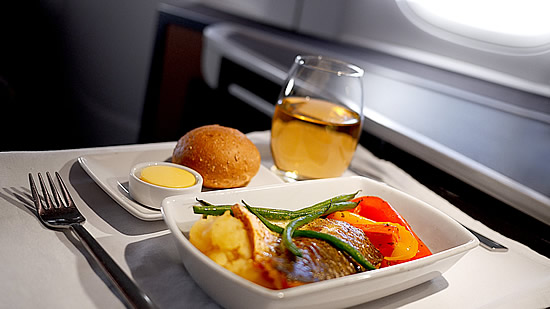What to eat at 30,000 feetArtemis Aerospace |
Mention airline food and most people will readily recount their experiences. This may include the ubiquitous packet of pretzels, but for a first-class menu, how do chefs plan, prepare and produce gourmet food for sky-high consumption?
Here, Artemis Aerospace explores the in-flight catering industry and the science behind delivering delicious meals on board.

The multi-million pound industry of in-flight catering is a topic which arouses heated discussion among frequent flyers. There is even a website dedicated entirely to airline meals and the ratings people have given them, with photos of each dish.
However, creating a gastronomic treat for first class passengers isn’t just a question of premium ingredients and catering expertise. According to research for Lufthansa by the Fraunhofer Institute, salt is perceived to be between 20 and 30% less intense and sugar 15 to 20% less intense at high altitude, and overall almost 70% of your sense of taste is lost. This is due to a combination of factors including the decibel level from the engine noise, and less than 12% humidity, which rivals a desert atmosphere.
As if this weren’t enough, low cabin pressure also decreases blood oxygen levels, which means that your olfactory receptors, which play a critical role in perceiving odours, become less sensitive. Around 85% of what we think of as ‘taste’ is actually due to our sense of smell. So when people accuse airline food of being bland, this may not be an entirely fair assumption!
Interestingly, spicy, bitter, sour and umami flavours are barely affected, garlic being one example, and some foods, like lemongrass and curry, are actually enhanced by airborne eating. It’s a well-documented fact that people will often crave tomato juice while flying, even if it’s not something they usually drink, because at altitude it tastes sweeter and more fruity.
Teams of executive chefs are employed by airlines to experiment with flavours and come up with dishes which are modified to allow for these changes in taste. Natural herbs and spices predominate rather than trying to increase salt levels, as too much sodium contributes to dehydration while in the air. Ingredients with bold flavours, such as mushrooms, hard cheeses, soy, ginger, cinnamon, cardamom and citrus fruits are popular choices, while more subtle flavour enhancers are largely ineffectual.
Once these concessions have been factored into a recipe, individual meals are prepared in state-of-the-art facilities close to the airport. Most airlines don’t have full kitchens for health and safety reasons, so an on-board chef is a rarity on commercial flights. A great deal of preparation goes in to forecasting upcoming food trends, such as the increasing popularity of plant-based foods or a particular type of world cuisine, and into the accommodation of special dietary requirements. Menus are also rotated to try to avoid people getting the same meal on a return flight.
Once they are prepared, dishes are chilled specifically to take the re-heating process into account, so it isn’t overcooked. Not all food is initially heated for the same length of time – for example, chicken will be cooked twice as long as beef. Meals are then transported to the aircraft.
During the entire catering process, a spotless environment is of paramount importance in order to comply with stringent hygiene regulations. In addition, if a flight is delayed for over six to eight hours, all perishable meals need to be discarded and a new tranche loaded. As a further safety check, although it’s not a legal requirement, many airlines state that the pilot and co-pilot should eat different meals to reduce the possibility of food poisoning.
Food is reheated in ovens on board to precisely the right temperature. Convection ovens have taken over from steam as they are better at maintaining the moisture in a dish; microwaves are not used on board because of safety issues. Cabin crew then distribute meals, with first class offerings served on fine china with all the accoutrements to enhance the experience.
Airlines will often have very precise requirements for their catering, for example requesting fruit cut to specific sizes to fit perfectly into the bowls. Portions also have to be identical as nobody wants to glance at a neighbour’s tray and see that their dessert is much bigger than yours.
The serving of wine to go with an airline meal is another area that has needed considerable experimentation. Like food, wine changes in taste when an aeroplane takes to the sky, losing fruitiness and becoming thinner, more tannic and acidic. If a passenger is jetting off to celebrate a special occasion, they may feel like ordering champagne, but unfortunately it’s high in acid so not the best choice. An ideal tipple is a fruity wine with low tannin - and also plenty of water to keep hydrated.
So next time you stow your luggage in the overhead locker and buckle up for your flight, whether you’re expecting lobster thermidor in first class or shepherd’s pie in economy, spare a thought for the work that has gone into producing the meal on your tray, and raise a low tannin glass to the caterers.
 |
Artemis Aerospace offers an innovative approach to component solutions for the aviation sector. Established in 1999, the company has earned a reputation for outstanding customer service by solving problems and providing a range of realistic options that offer customers the flexibility and freedom to choose a solution that suits their timescale and budget. Its services include component supplies, component repairs, lessor support, flight simulation hardware support, consignment stock management and global aircraft logistics.
With decades of expertise in global aviation logistics, the expert team works with trusted MROs, OEMs, and aftermarket suppliers around the world to offer 24/7 support to its global customer base.





